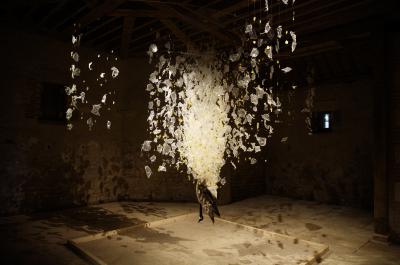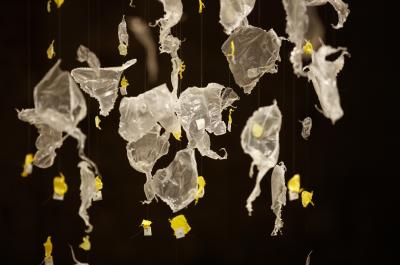F. Claire Morgan
"Être seul avec toi / To be alone with you"

Claire Morgan’s delicate installations testify to her close attention to the natural environment and the beings that inhabit it. In her eyes, everything that nature produces is more beautiful than no matter what human creation. In impressively geographical mises en scène, animals she has stuffed herself hold up a mirror reflecting our human condition. It’s a question of life and death, nature and artifice, blood and synthetic, reality and illusion. The grace of a posture vies with the beauty of a beast, as well as with the fragility of its existence. Even though the question of passing time is constantly addressed by the artist, her sculptural installations seek to bind it in the movement of life, not in the fear of death. But that wasn’t always the case.
As regards her sources of inspiration, Claire Morgan cites such authors as David Foster Wallace, along with academics, international stars including the Icelandic singer-songwriter Bjork and such British electronic music composers as Aphex Twin. Turning to the visual arts, Claire Morgan, logically enough, is interested in minimalism, Arte Povera and abstract expressionism. In her pantheon, Eva Hesse and Giuseppe Penone rub shoulders with Joan Mitchell and Cy Twombly. Not forgetting Francis Bacon and Rebecca Horn.
The development of taxidermy didn’t just transform Claire Morgan’s sculptural practice, it also impacted her drawing. As this particular discipline was by no means prioritised in her university curriculum, the artist initially only produced sketches of her installations, enabling her to explain her ideas and/or create atmospheres. But it didn’t take long before sheets of paper made their way under the animals ready to be skinned. Each of the artist’s actions is printed on them, while spots of blood and fluids later serve as a basis for drawings envisaged as a different approach to the idea that underlies the installation in preparation.
Little by little, the work on the paper evolves into a larger format drawing/painting. This unknown territory inspires the artist. Far removed from her installations’ well-oiled procedures and scenarios, she leaves her comfort zone, fearful yet fascinated. In a video made in April 2020 (in mid-lockdown) and still accessible on the web, Claire Morgan explains the drawings/painting underway. She now uses raw pigments, colourful mineral and organic components that complement her usual palette. For her, materials and the creative process are just as important as the final result, if not more so.
Attentive to the smallest detail, Claire Morgan works with extreme concentration, obliging her to be fully present in each of her actions. This “life” that she contrives to introduce into her work is inherently responsible for much of the unpredictability that sometimes brings changes to her projects. On the paper, a bird’s dead body leaves the imprint of its passage while the artist’s hand readies itself to turn the movements made in the throes of death into a new flight. For her, the power of gravity is a departure point, a permanent source of inspiration and questioning.
The phenomenon that affects living and inert alike reminds all bodies of an unchangeable rule that governs our nature and, in Claire Morgan’s works, echoes the disappearance/transformation of all things. Work that exalts the world’s impermanence. “Everything evolves, everything changes. What exists today won’t always be here. I think that something extremely positive may result from this exploration. Every time I chose to ignore this perpetual change, I realised that I’d also forgotten to take notice of all the beauty around”, asserts the artist whose body of work is nothing less than a eulogy to the ephemeral.
BIOGRAPHICAL NOTES

Claire Morgan was born in Belfast in 1980 and grew up in Northern Ireland.
Claire Morgan is certain of one thing: she has always been drawn to art. In a family home surrounded by nature, the little girl spent a great deal of time drawing and making “things”, using what she had gleaned in her favourite playground, the fields. If she hasn’t got many memories of other children, it isn’t because she was lonely but rather that she was already totally absorbed in creation. A tendency that continued to grow during her teenage years, even keeping her in the classroom at lunchtime so that she could continue with her drawings. The young Claire didn’t know what else to do except immerse herself fully in her artistic concerns, to the point of forgetting what she was supposed to be doing. She must have been 12 or 13 years old when her teacher asked each of his pupils to choose a painting and recreate a detail from it in their sketchbooks, she couldn’t do otherwise than reproduce her chosen work in its entirety. It was a painting by “Douanier” Rousseau. An experience evoked today through one of her paintings that borrows a title from the painter but whose subject is different.
In Belfast, tension was omnipresent. Telling someone your first name or the name of your school could be dangerous, as they both indicated your religious affiliation. Claire Morgan never came face to face with the horror of bombings and murders but she remembers people spitting on her uniform and British soldiers in position on the road to school, their guns pointing at the passers-by. The time came when she had to decide what she wanted to study at university and she came close to choosing the fashion world. She remembers creating a dress at the time, with a metal frame she had arranged plants around. Realising that her creation was more of an installation than a garment, she chose to enrol in the University of Northumbria’s sculpture department. She graduated from the university in 2003. She had no intention, however, of sitting back and waiting for a gallery to send an invitation and decided to organise her first exhibitions herself. No bad idea, as success wasn’t slow in coming. In 2008, she began a series of solo exhibitions across England, starting with The Fall in London, and then in Germany and France, thanks to the good offices of the Karsten Greve Gallery. Geometrising space, the young artist used subtle arrangements of nylon thread to enclose small dead animals within poetically abstract forms covered in bits of plastic, fruit and plants. A moth stays its flight (Diamond, 2011), yellows canaries escape from a tangle of ginkgo leaves (Fall Out, 2010). She spoke of the fragility of the natural world and the risk humankind runs if they destabilise it. Her installations created a contrast between the beauty of nature and the vulgarity of the consumer society. She had found her voice and would never deviate from it.
As was the case in the days when she stayed in her classroom to create, these days Claire Morgan spends months on end shut up in her workshop masterfully turning out increasingly complex pieces and drawings that have become paintings, one after the other. They are to be found in prestigious public and private collections across the world, including in the ALTANA Kulturstiftung, Bad Homburg, in Germany; the MONA (Museum of Old and New Art) in Hobart, Australia; the Centre Pompidou in Paris, France; and the Ghisla Art Collection in Locarno, Switzerland. Claire Morgan’s work has also been presented on numerous occasions in the United States, where she has taken part in many group exhibitions.
Claire Morgan is represented by Galerie Karsten Greve (Cologne – Paris – St Moritz).


